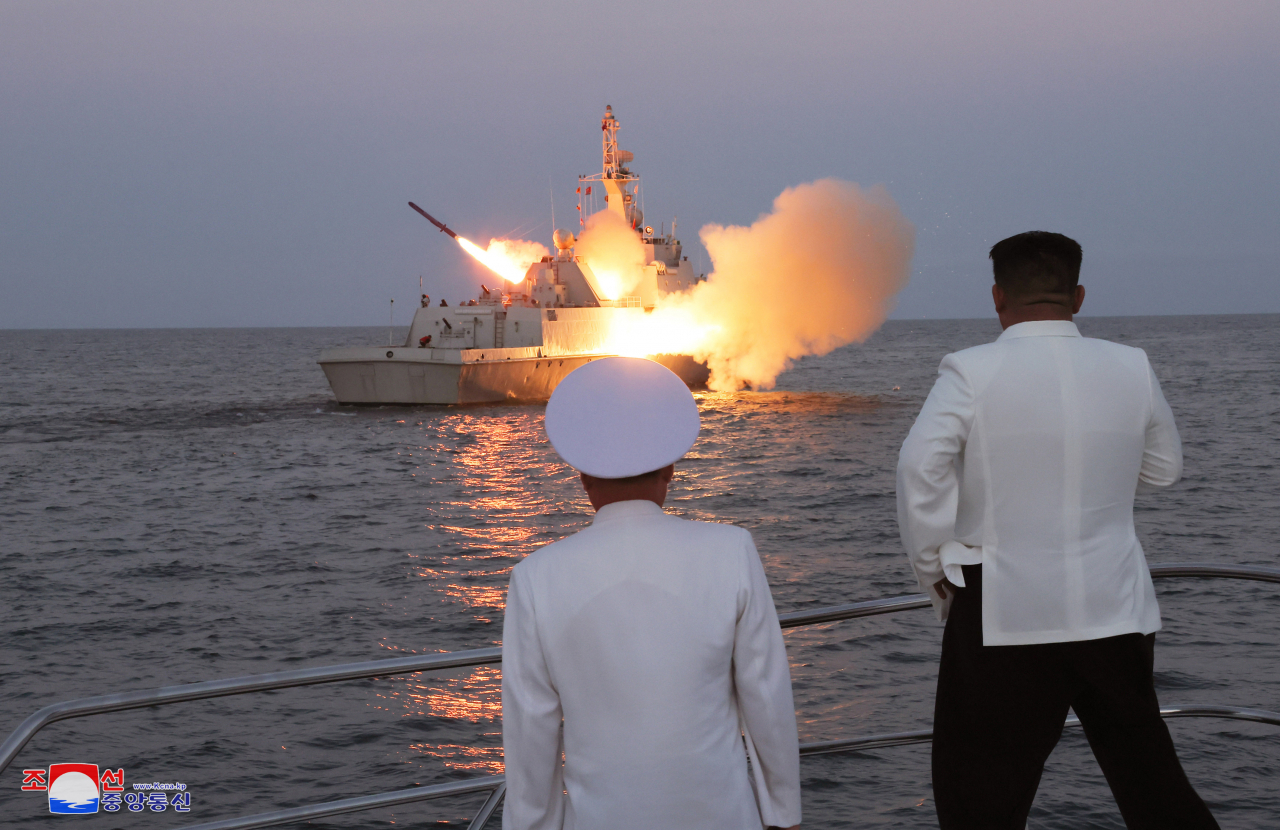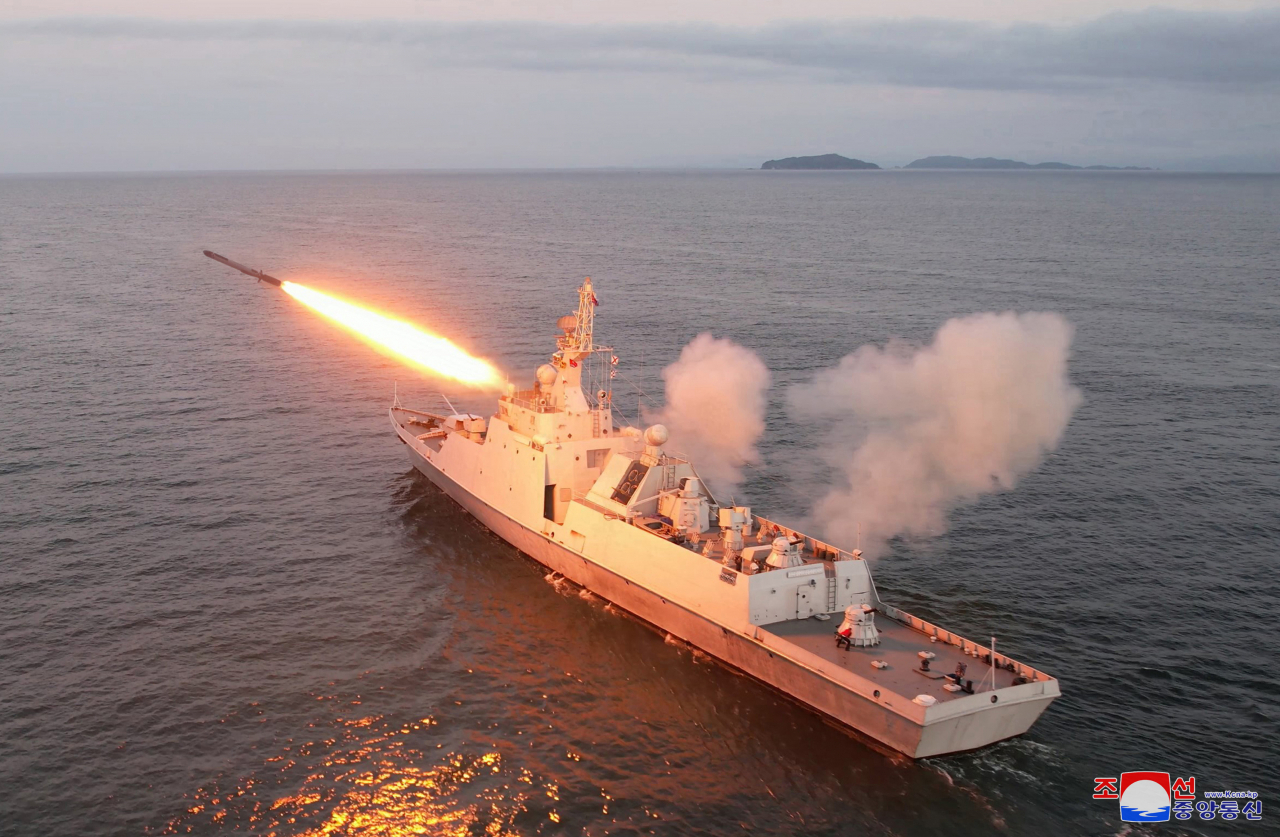S. Korean military denies NK report on 'strategic' cruise missile drills
Some experts say NK corvette capable of firing long-range cruise missile
By Ji Da-gyumPublished : Aug. 21, 2023 - 15:23

The South Korean military on Monday refuted a belated report from North Korean state media that "strategic cruise missiles" were fired from a newly revealed naval corvette as part of its live-fire drills.
Earlier in the morning, North Korean state media reported that North Korean leader Kim Jong-un had inspected the Guards 2nd Surface Ship Flotilla of the East Sea Fleet of the Navy of the Korean People's Army. Without elaborating on the date, the report also mentioned his observation of the launch of "strategic cruise missiles" from "Patrol Ship No. 661."
Kim reportedly received a comprehensive overview of the naval fleet's preparedness for combat mobilization and wartime readiness, the daily military routines of soldiers and strategies for upgrading a naval port. Kim was aboard Patrol Ship No. 661, which will soon be designated for maritime surveillance duty.
"At the drill aimed to reconfirm the combat function of the ship and the feature of its missile system and make the seamen skilled at carrying out the attack mission in actual war, the ship rapidly hit target without even an error," read an English-language report from North Korea’s state-run Korean Central News Agency. "As a result, the ship's regular posture for mobilization and offensive ability were perfectly appreciated."
Subsequently, Kim articulated the party's directive to bolster and advance its navy into a self-reliant force with comprehensive capabilities. This involves substantially elevating its combat preparedness and outfitting it with "significantly upgraded combat capabilities, encompassing state-of-the-art surface and underwater offensive and defensive systems."
"The information provided by North Korea is exaggerated and contains multiple inconsistencies with the actual facts," South Korea's Joint Chiefs of Staff said in a statement in response to the North Korean media report. "Both South Korea and the United States preemptively detected pertinent indications and closely monitored the situation in real time."
South Korea's JCS disputed every aspect of the North Korean state media's account.
"Primarily, this does not qualify as a strategic cruise missile. To apply the term 'strategic,' it would necessitate the inclusion of a nuclear warhead," a senior official from the JCS -- who requested to remain anonymous -- said during a closed-door briefing.
"Hence, on vessels of such small scale, it is more typical to deploy anti-ship missiles, which fall under the category of cruise missiles. Therefore, the two are different types of missiles. This distinction underscores that the (launched anti-ship) missiles have limited ranges and do not possess a strategic nature," the official clarified.
Anti-ship cruise missiles are meticulously crafted to pinpoint and engage naval vessels, rendering them a distinct subset of cruise missiles tailored for naval warfare scenarios.
South Korea's JCS braced for the possibility of North Korea launching existing anti-ship missiles or their upgraded version.
North Korea might launch an upgraded variant of the Kumsong-3 or KN-19, their rendition of the Soviet-originated Kh-35 Uran anti-ship cruise missile. The KN-19 is widely believed to encompass a range of 130 to 250 kilometers.

Differing opinions
But there are opinions among some experts based in Seoul that differ from assessments of the JCS.
Shin Jong-woo, a senior analyst at the Korea Defense and Security Forum, emphasized that a naval vessel of 1,500 to 2,000 tons would indeed possess sufficient capacity to accommodate the launch of long-range cruise missiles.
"The missile(s) launched shares resemblances in shape and paint with North Korea's Hwasal-2 (long-range land-attack cruise missile), setting it apart from existing anti-ship missiles modeled after the Kh-35 Uran," Shin told The Korea Herald.
"It appears that North Korea conducted an initial flight test with the objective of demonstrating the operation and launch of a cruise missile from the naval vessel. As a result, the observed range of the launch appears to be relatively restricted."

Ryu Seong-yeop, an intelligence analyst at the Korea Research Institute for Military Affairs, reiterated the significance of not underestimating North Korea's progress in missile development, pointing to the case of the 2010 Cheonan sinking where North Korea's acoustic homing torpedo technology was overlooked.
"As a case in point, when evaluating missile sizes the disparities in dimensions between short-range and long-range cruise missiles are not substantial. Even a comparison of the dimensions of the (US) Harpoon and Tomahawk cruise missiles reveals a difference of approximately 10 centimeters in diameter and 1-2 meters in length," Ryu told The Korea Herald.
"Given that the maximum length of medium to long-range cruise missiles, like the Tomahawk, is around 6 meters, it's crucial to acknowledge the potential for the short-range cruise missile launched to be upgraded into a Hwasal-type medium-range cruise missile."
When asked about the rationale behind the silence maintained by both South Korea and the US despite the real-time detection of the missile launch, the JCS official clarified, "Anti-ship missiles of this nature have relatively limited ranges and aren't typically viewed as highly threatening capabilities."
The JCS also rejected the North Korean state media's assertion that the missiles had successfully hit their target. The military clarified that in past cases, state media had released images or videos of successful strikes. However, as of Monday morning, no such evidence had been presented.
"Furthermore, according to data collected by our surveillance equipment, it seems that the missile did not hit its intended target," the official said.
Regarding the newly disclosed North Korean Navy corvette, the official clarified that its construction dates back over 10 years, indicating it is not a recently built vessel.
The JSC official also confirmed that the missile launches occurred on a weekday during the previous week.
The media report came on the first day of Ulchi Freedom Shield, a routine defense-focused computer-simulated military exercise conducted by South Korea and the United States. The allies plan to stage 38 field training exercises associated with the exercise.
Choi Il, a former South Korean submarine captain, additionally noted that North Korea's state media report is evidently a direct and straightforward response triggered by the initiation of the UFS exercise.
Choi took note of Kim Jong-un's emphasis on bolstering defensive naval capabilities alongside offensive measures during the inspection.
"This underscores North Korea's apprehension regarding the naval capabilities of South Korea or the collective naval strength of South Korea, the US and Japan," Choi said. "North Korea's emphasis on its navy reflects its determination to respond in kind to the unified naval presence, particularly amid the recent strengthening of collaborative efforts between South Korea, the US and Japan."




















